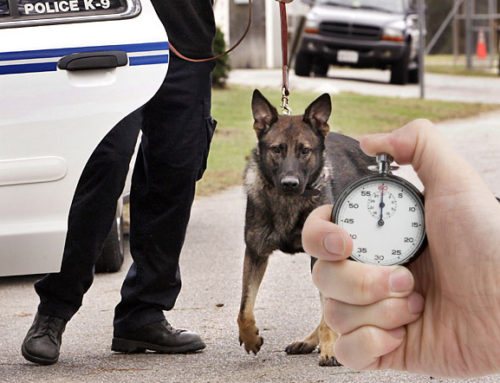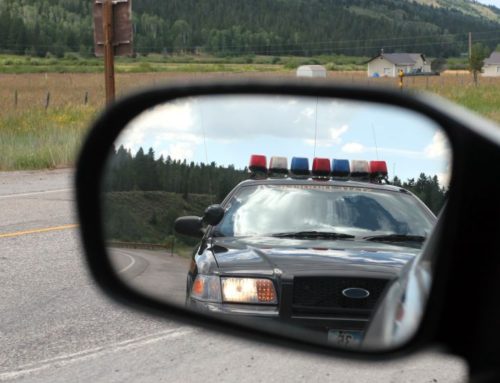When can you put your dog into a vehicle to conduct a K-9 search inside the car? What if my dog jumps into the car on his own during the search? Every class I am involved in teaching at the Little Rock K9 Academy these questions alway come up. Most everyone, myself included, likes to have a black and white answer to these types of questions.
The problem with search and seizure is that it is often times not black and white. Courts will disagree on cases, even supreme court judges disagree with each other when interpreting the laws and applying it to cases. Hopefully I will shed some light on the topic of when your dog can enter a vehicle during a search for contraband.
Without question you and your K9 can conduct a search of the interior of a vehicle if you have one of the following
- Consent – for those of you who know me you probably know I am a huge fan of gaining consent the proper and legal way. It is probably the most powerful tool available to you when it comes to searches and seizures and when used correctly will make a strong case for the prosecution in court.
- Probable Cause – probable cause can be established in many ways including plain view, plain smell, information known to you, an alert by a (properly trained, certified, and reliable) K9 on the exterior of the vehicle.
- Search Warrant – vehicles present at a house or other location subject to search warrant (if vehicle is included in warrant or the subject of the warrant).
So what if while doing a K-9 search your dog jumps in through an open window, or door, or hatch?
Most recently this has been addressed in the 10th Circuit Court of Appeals in (Felders v. Malcom). The case is actually an instance where the occupants of the vehicle filed a suit against the officers for fourth amendment violations. Yep, thats right, and it’s not really a favorable outcome. The quick version is this; traffic stop was made, consent was denied, K9 was called, during a K-9 search the dog jumped into car and alerted, car was searched for two hours, nothing was located. Officers are being sued. The K9 officer asked for qualified immunity and it was denied, he appealed to 10th circuit and again was denied. (Take note here handlers, the stop was made by another officer and the handler was called to the scene after consent was denied so the handler was not even the one who made the stop).
After reading this case and several other cases on this topic I am going to provide some general guidelines for the use of a dog inside of a car as set forth by the clearly established case laws. If while conducting a sniff of the interior of a car with your dog and he enters the car through a window, open door, open hatch, etc and provides you with an alert what questions do you need to answer for the court?
- Did the dog enter the vehicle on his own accord? The basic rule of thumb is that the dogs entry into the vehicle will be allowed as long as he entered on his own in an attempt to go to the source of the odor of an illegal substance that he is trained to detect.
- Did you facilitate his entry into the vehicle? The K9 handler or other officers are not allowed to do ANYTHING to facilitate the entry of your dog into the car. If you intentionally leave a door open, tell the person to leave a door open, direct the occupants to leave the windows open, command the dog to enter the car, or encourage the dog to enter the car, the court will most likely rule that the entry was unlawful and you may loose any evidence or be found liable in any rights violation lawsuits. The court found that the law clearly established that “an improper search occurs if an officer facilitates a drug dog’s entry into a vehicle before probable cause has been established”
- Did you train the dog to perform this action? It is important that we do not train or encourage our dogs to enter into the vehicle through an open window or door. It is one of those areas that I would completely avoid in training. While conducting training I would arrange it so that the dog does not have free access to the interior of a car unless I grant him entry. This way in the event that you ever find yourself in the position to justify the entry of your dog or to defend yourself in a lawsuit you can testify and provide training notes to document that this practice was never taught or encouraged. The fact that you do not train for this and do not encourage this behavior in your dog should also verify to you (and the court) that if your dog jumps into a vehicle while conducting a search that he is in fact in odor and attempting to locate the source of that odor. This behavior will be “out of the ordinary behavior” for your dog and should be another clue as to a distinct change in behavior that he is in fact “in odor.”
- Was probable cause already established? In the event your dog provided you with a positive alert prior to entry into the vehicle or you were authorized by consent or a warrant then your dog searching the interior of a vehicle will be authorized.
To make sure we are doing the right things right and to protect from any liability I suggest if you find yourself in the situation where your dog made entry into the car on his own during the sniff of the vehicle whether or not you located drugs or arrested someone to be sure and document everything completely in your report and ensure any video evidence is maintained. No only does this preserve any evidence for you on the current case you are on but it helps build your K9 track record and history with your dog. The “K9 Sniff” is a free air sniff around the exterior of a car to where the person has no expectation of privacy to the air surrounding their vehicle. Once the dog goes into the car we are conducting a “K9 Search”. The action of the dog going into the car should be reliable behavior and viewed as part of the overall alert picture, the change in behavior, the working out of the odor, etc.
For additional research on the K9 entry into car topic see:
United States v. Vazquez, (no constitutional violation where “(1) the dog’s leap into the car was instinctual rather than orchestrated, and (2) the officers did not ask the driver to open the point of entry, such as a hatchback or window, used by the dog.”);
United States v. Winningham, (dog’s jump into car through door officers opened and where evidence indicated a desire to facilitate the dog’s entrance into the interior violated the Fourth Amendment);
United States v. Stone, (dog’s instinctive leap into hatchback of car that defendant opened, absent any evidence that officers encouraged the dog’s entry or asked defendant to open door so dog could enter did not violate the Fourth Amendment);
United States v. Sharp, (“It is a Fourth Amendment violation for a narcotics detection dog to jump into a car because of something the police did, like training the dog to jump into cars as part of the search or facilitating or encouraging the jump”, but no violation occurs “as long as the canine enters the vehicle on its own initiative and is neither encouraged nor placed into the vehicle by law enforcement”); United States v. Pierce.











